Scientists at the Department of Energy’s Fermi National Accelerator Laboratory and the University of Chicago have demonstrated a new technique based on quantum technology that will advance the search for dark matter, the invisible stuff that accounts for 85% of all matter in the universe.
The collaboration has developed superconducting versions of devices called qubits that will be able to detect the weak signals emitted by two kinds of hypothetical subatomic particles that could reside in an invisible but ubiquitous part of the universe called the dark sector. One is called an axion, a leading dark matter candidate. The other is called a hidden photon, a particle that possibly interacts with the photons — particles of light — of the visible universe.
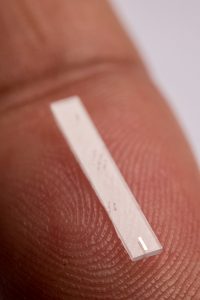
A qubit (the small rectangle) is set onto a sapphire substrate, which sits upon a fingertip to show scale. Fermilab and University of Chicago scientists used a qubit similar to this one to develop a technique that will speed up the search for axion dark matter and hidden photons. Photo: Reidar Hahn, Fermilab
The technique now demonstrated by the Fermilab-University of Chicago team is 36 times more sensitive to the particles than the quantum limit, a benchmark of conventional quantum measurements, enabling searches for dark matter to proceed 1,000 times faster.
Using light to detect dark particles
In the technique, the qubits are designed to detect the photons that would be produced when dark matter particles interact with an electromagnetic field. The benefit of using qubits as detectors instead of the conventional technology lies in the way they interact with photons.
The key to the technique’s sensitivity is its ability to eliminate false-positive readings. Conventional techniques destroy the photons they measure. But the new technique can probe the photon without destroying it. Making repeated measurements of the same photon, over the course of its 500-microsecond lifetime, provides insurance against erroneous readings.
“To make a measurement of the photon once with the qubit takes about 10 microseconds, so we can make about 50 repeated measurements of the same photon within its lifetime,” said Akash Dixit, a doctoral student in physics at the University of Chicago.
Dixit and his co-authors, including Fermilab’s Aaron Chou, describe their technique in Physical Review Letters.
“Experiments using conventional techniques were just nowhere near what they needed to be for us to be able to detect higher-mass axion dark matter,” Chou said. “The noise level is way too high.”
There are two ways to make an experiment more sensitive to the subtle hints of new physics that the scientists are looking for. One is to boost the signal by making larger detectors. Another to reduce the noise levels that hide the target signals. The Fermilab-University of Chicago team did the latter.
“It’s a much more clever and cheaper way to get the same large improvements in sensitivity,” Chou said. “Now, the level of the static noise has been reduced by so much that you have a chance to actually see the very first small wiggles in your measurements due to the very, very tiny signal.”
The technique will benefit the search for any dark matter candidate because, when invisible particles convert into photons, they can be detected.
“Where the conventional method may generate one photon of noise with every measurement, in our detector you get one photon of noise every thousand measurements you make,” Dixit said.
Dixit and his colleagues adapted their technique from one developed by atomic physicist Serge Haroche, who shared the 2012 Nobel Prize in physics for his feat. Chou views the new technique as part of the progression that started with the development of nondemolition interaction in atomic physics and is now imported to the field of superconducting qubits.
Ferreting out axions and hidden photons
Physicists have made little progress in detecting axions since their existence was proposed more than 30 years ago.
“We know that there’s a huge amount of mass all around us that isn’t made of the same stuff you and I are made of,” Chou said. “The nature of dark matter is a really compelling mystery that a lot of us are trying to solve.”
Superconducting microwave cavities are vital to the new technique. The cavity used in the experiment is made of highly pure — 99.9999% — aluminum. At extremely low temperatures, the aluminum becomes superconducting, a property that extends the longevity of qubits, which by their nature are short-lived. The superconducting cavity provides a way to accumulate and store the signal photon. The qubit, an antenna inserted into the cavity, then measures the photon.
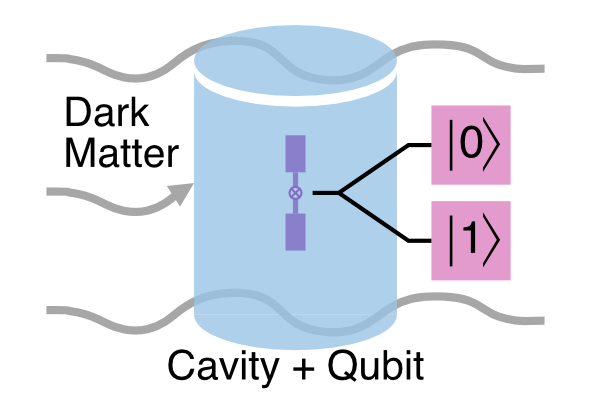
The blue cylinder in this diagram represents a superconducting microwave cavity used to accumulate a dark matter signal. The purple is the qubit used to measure the state of the cavity, either 0 or 1. The value refers to the number of photons counted. If the dark matter has successfully deposited a photon in the cavity, the output would measure 1. No deposition of a photon would measure 0. Image: Akash Dixit, University of Chicago
“The benefit we get is that, once you — or dark matter — puts a photon in the cavity, it’s able to hold the photon for a long time,” Dixit observed. “The longer the cavity holds the photon, the longer we have to make a measurement.”
The same technique can find hidden photons and axions; the latter will require a high magnetic field to detect.
If axions exist, the current experiment provides a one-in-10,000 chance that it would detect a photon produced by a dark matter interaction.
“To further improve our ability to sense such a rare event, the temperature of the photons needs to be lowered,” said David Schuster, University of Chicago associate professor of physics and a co-author of the new paper. Lowering the photon temperature will further increase sensitivity to all dark matter candidates, including hidden photons.
The photons in the experiment have been cooled to a temperature of approximately 40 millikelvins (minus 459.60 degrees Fahrenheit), just a touch above absolute zero. The researchers would like to go as low as the operating temperature of 8 millikelvins (minus 459.66 degrees Fahrenheit). At this point, the environment for searching for dark matter would be spotless, effectively free of background photons.
“While there’s definitely still a ways to go, there’s reason to be optimistic,” said Schuster, whose research group will apply the same technology to quantum computing. “We’re using quantum information science to help the dark matter search, but the same kind of background photons are also a potential error source for quantum computations. So this research has uses beyond fundamental science.”
Schuster said the project provides a nice example of the type of collaboration that makes sense to do between a university lab and a national lab.
“Our university lab had the qubit technology, but in the long term by ourselves, we were not really able to do any kind of dark matter search at the level needed. That’s where the national-lab partnership plays an important role,” he said.
The payoff from this cross-disciplinary effort could be huge.
“There’s just no way to do these experiments without the new techniques that we developed,” Chou said.
Funding for the experiment comes from the Heising-Simons Foundation and the DOE Office of Science through the High Energy Physics QuantISED program.
Fermilab is supported by the Office of Science of the U.S. Department of Energy. The Office of Science is the single largest supporter of basic research in the physical sciences in the United States and is working to address some of the most pressing challenges of our time. For more information, please visit energy.gov/science.
The long-awaited first results from the Muon g-2 experiment at the U.S. Department of Energy’s Fermi National Accelerator Laboratory show fundamental particles called muons behaving in a way that is not predicted by scientists’ best theory, the Standard Model of particle physics. This landmark result, made with unprecedented precision, confirms a discrepancy that has been gnawing at researchers for decades.
The strong evidence that muons deviate from the Standard Model calculation might hint at exciting new physics. Muons act as a window into the subatomic world and could be interacting with yet undiscovered particles or forces.
“Today is an extraordinary day, long awaited not only by us but by the whole international physics community,” said Graziano Venanzoni, co-spokesperson of the Muon g-2 experiment and physicist at the Italian National Institute for Nuclear Physics. “A large amount of credit goes to our young researchers who, with their talent, ideas and enthusiasm, have allowed us to achieve this incredible result.”
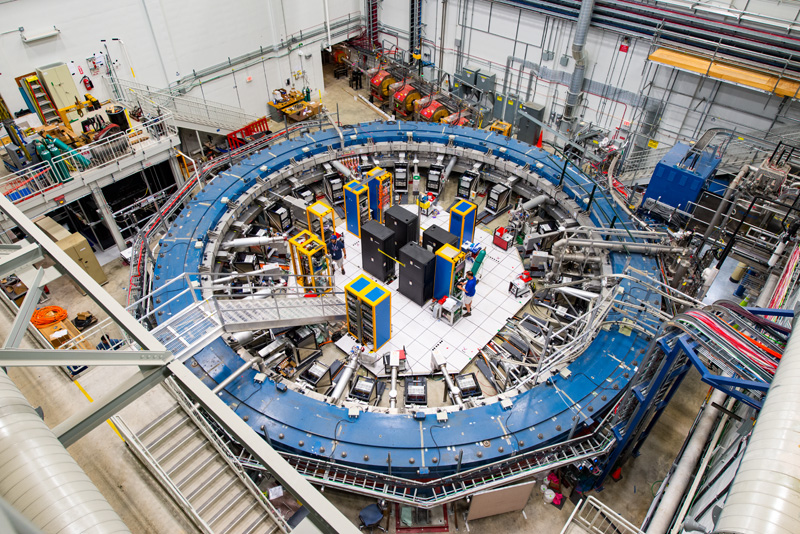
First results from the Muon g-2 experiment at Fermilab have strengthened evidence of new physics. The centerpiece of the experiment is a 50-foot-diameter superconducting magnetic storage ring, which sits in its detector hall amidst electronics racks, the muon beamline, and other equipment. This impressive experiment operates at negative 450 degrees Fahrenheit and studies the precession (or wobble) of muons as they travel through the magnetic field. Photo: Reidar Hahn, Fermilab
A muon is about 200 times as massive as its cousin, the electron. Muons occur naturally when cosmic rays strike Earth’s atmosphere, and particle accelerators at Fermilab can produce them in large numbers. Like electrons, muons act as if they have a tiny internal magnet. In a strong magnetic field, the direction of the muon’s magnet precesses, or wobbles, much like the axis of a spinning top or gyroscope. The strength of the internal magnet determines the rate that the muon precesses in an external magnetic field and is described by a number that physicists call the g-factor. This number can be calculated with ultra-high precision.
As the muons circulate in the Muon g-2 magnet, they also interact with a quantum foam of subatomic particles popping in and out of existence. Interactions with these short-lived particles affect the value of the g-factor, causing the muons’ precession to speed up or slow down very slightly. The Standard Model predicts this so-called anomalous magnetic moment extremely precisely. But if the quantum foam contains additional forces or particles not accounted for by the Standard Model, that would tweak the muon g-factor further.
“This quantity we measure reflects the interactions of the muon with everything else in the universe. But when the theorists calculate the same quantity, using all of the known forces and particles in the Standard Model, we don’t get the same answer,” said Renee Fatemi, a physicist at the University of Kentucky and the simulations manager for the Muon g-2 experiment. “This is strong evidence that the muon is sensitive to something that is not in our best theory.”
The predecessor experiment at DOE’s Brookhaven National Laboratory, which concluded in 2001, offered hints that the muon’s behavior disagreed with the Standard Model. The new measurement from the Muon g-2 experiment at Fermilab strongly agrees with the value found at Brookhaven and diverges from theory with the most precise measurement to date.
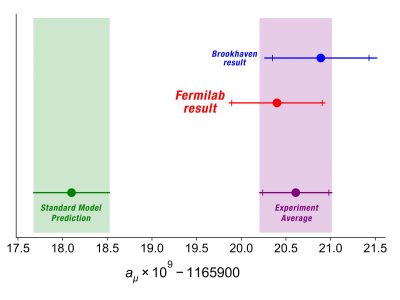
The first result from the Muon g-2 experiment at Fermilab confirms the result from the experiment performed at Brookhaven National Lab two decades ago. Together, the two results show strong evidence that muons diverge from the Standard Model prediction. Image: Ryan Postel, Fermilab/Muon g-2 collaboration
The accepted theoretical values for the muon are:
g-factor: 2.00233183620(86)
anomalous magnetic moment: 0.00116591810(43)
[uncertainty in parentheses]
The new experimental world-average results announced by the Muon g-2 collaboration today are:
g-factor: 2.00233184122(82)
anomalous magnetic moment: 0.00116592061(41)
The combined results from Fermilab and Brookhaven show a difference with theory at a significance of 4.2 sigma, a little shy of the 5 sigma (or standard deviations) that scientists require to claim a discovery but still compelling evidence of new physics. The chance that the results are a statistical fluctuation is about 1 in 40,000.
The Fermilab experiment reuses the main component from the Brookhaven experiment, a 50-foot-diameter superconducting magnetic storage ring. In 2013, it was transported 3,200 miles by land and sea from Long Island to the Chicago suburbs, where scientists could take advantage of Fermilab’s particle accelerator and produce the most intense beam of muons in the United States. Over the next four years, researchers assembled the experiment; tuned and calibrated an incredibly uniform magnetic field; developed new techniques, instrumentation, and simulations; and thoroughly tested the entire system.
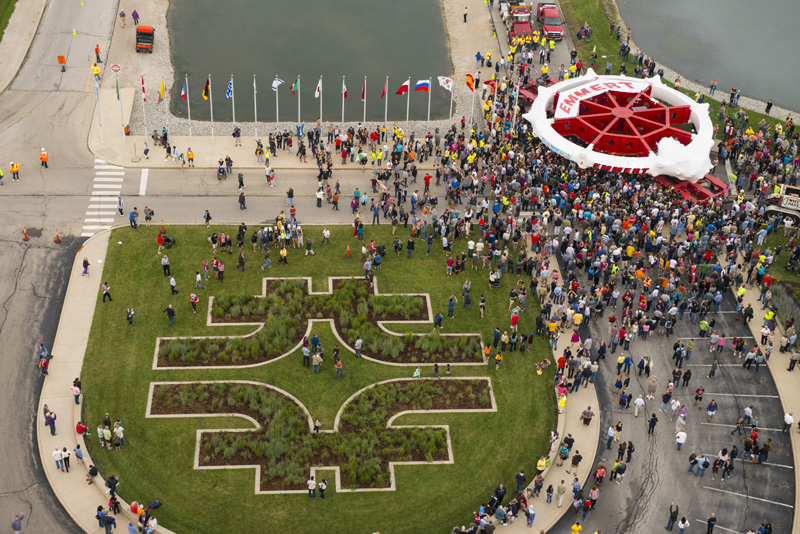
Thousands of people welcomed the Muon g-2 magnet to Fermilab in 2013. Data from the experiment’s first run has yielded a result with unprecedented precision. Data from four additional experimental runs will reveal the muon’s behavior in even more detail. Photo: Reidar Hahn, Fermilab
The Muon g-2 experiment sends a beam of muons into the storage ring, where they circulate thousands of times at nearly the speed of light. Detectors lining the ring allow scientists to determine how fast the muons are precessing.
In its first year of operation, in 2018, the Fermilab experiment collected more data than all prior muon g-factor experiments combined. With more than 200 scientists from 35 institutions in seven countries, the Muon g-2 collaboration has now finished analyzing the motion of more than 8 billion muons from that first run.
“After the 20 years that have passed since the Brookhaven experiment ended, it is so gratifying to finally be resolving this mystery,” said Fermilab scientist Chris Polly, who is a co-spokesperson for the current experiment and was a lead graduate student on the Brookhaven experiment.
Data analysis on the second and third runs of the experiment is under way, the fourth run is ongoing, and a fifth run is planned. Combining the results from all five runs will give scientists an even more precise measurement of the muon’s wobble, revealing with greater certainty whether new physics is hiding within the quantum foam.
“So far we have analyzed less than 6% of the data that the experiment will eventually collect. Although these first results are telling us that there is an intriguing difference with the Standard Model, we will learn much more in the next couple of years,” Polly said.
“Pinning down the subtle behavior of muons is a remarkable achievement that will guide the search for physics beyond the Standard Model for years to come,” said Fermilab Deputy Director of Research Joe Lykken. “This is an exciting time for particle physics research, and Fermilab is at the forefront.”
A press conference discussing the Muon g-2 experiment’s first results will be held at noon US Central Time on April 7. Reporters should contact media@fnal.gov for connection information. More images of the Muon g-2 experiment are available in the Muon g-2 gallery. More information about the experiment is available at the Muon g-2 website.
More ways to engage: Take a virtual 360 tour of the Muon g-2 experiment or watch a guided video tour. View the full Muon g-2 video playlist. Register for a free virtual public lecture on April 17 that will explain the new Muon g-2 results. Print your own “Marvelous Muon” poster.
The Muon g-2 experiment is supported by the Department of Energy (US); National Science Foundation (US); Istituto Nazionale di Fisica Nucleare (Italy); Science and Technology Facilities Council (UK); Royal Society (UK); European Union’s Horizon 2020; National Natural Science Foundation of China; MSIP, NRF and IBS-R017-D1 (Republic of Korea); and German Research Foundation (DFG).
Fermilab is America’s premier national laboratory for particle physics research. A U.S. Department of Energy Office of Science laboratory, Fermilab is located near Chicago, Illinois, and operated under contract by the Fermi Research Alliance LLC. Visit Fermilab’s website at https://www.fnal.gov and follow us on Twitter @Fermilab.
The DOE Office of Science is the single largest supporter of basic research in the physical sciences in the United States and is working to address some of the most pressing challenges of our time. For more information, visit https://science.energy.gov.
